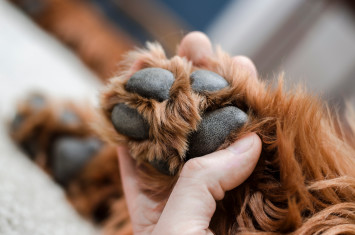
You’ve likely heard that winter can be brutal on your dog's paws. Bitter cold, rock salt, and chemicals to melt ice can cause chapping, cracking, sores, infection, and blistering. But did you know that summertime presents its own unique set of dangers to your pup’s paw pads?
The summer sun can turn sidewalks and streets into a sizzling danger zone for your dog's delicate paw pads. When the temperature rises, surfaces like asphalt, concrete, metal, and brick can become scorching hot, posing a serious risk of burns and blisters to your dog's sensitive paw pads. But don't sweat it - we've got you covered with expert tips to keep your furry friend's paws safe all season long!
What Temperature is Too Hot for Dogs to Walk on Pavement?
Outdoor surfaces can reach blazing temperatures quickly under the summer sun. As a general rule, if the pavement feels too hot for you to comfortably press your hand against for at least 10 seconds, it's too hot for your dog's paws.
If the air temperature is 85°F, asphalt temperatures can reach 130°F! To prevent paw pad burns and blisters, it's best to avoid walking your dog on hot pavement, sidewalks, and other man-made surfaces during the peak heat of the day.

Source: The heat is on: how hot common outdoor surfaces can get in the summer sun
Signs Your Dog's Paws Are Burned from Hot Pavement
Many owners don't notice a paw pad injury or burn until their dog shows signs of pain. Watch for limping, refusal to stand or walk, atypical pulling on the leash to get to cooler surfaces, obsessive licking or chewing at paws, and pads that are darker than usual or have visible damage like blisters or redness.
Burns aren't the only risk of hot pavement - heat stroke is a serious concern as well. Watch for signs like heavy panting, drooling, lethargy, vomiting, diarrhea, and red or purple gums. In severe cases, dogs may experience dizziness, seizures, or loss of consciousness. If you notice these symptoms, seek veterinary care immediately as heat stroke can be life-threatening.
First Aid for Burned Paw Pads
If you suspect burned paw pads, get your dog to a grassy or shaded area, carrying them if possible. Flush the paw pads with cool water or apply a cool compress if available. See your vet as soon as possible to check for deeper burns, blisters, and infection. Your vet will determine if medications are needed and show you how to clean and bandage the paws. An e-collar or cone may be advised to prevent your dog from licking or chewing at their bandages.
Tips for Protecting Your Dog's Paw Pads from Hot Pavement
Walk your dog in the early morning or late evening when surfaces are cooler, and stick to the grass or shaded sides of the street. Avoid artificial grass and turf which can get extremely hot. Consider using protective dog booties if your dog will tolerate them. If you opt for dog boots, it's important to acclimate your dog to them slowly. Let them wear the boots for short periods indoors, gradually increasing the time. Ensure a proper fit - boots should be snug but not tight, allowing room for the paws to breathe.
Paw protecting ointments can help create a barrier between your dog's paws and the hot pavement. Commercial paw waxes are specifically designed to protect against heat, as well as cold weather and rough terrain. When applied before walks, these waxes form a protective layer on the paw pads, reducing the risk of burns and injuries.
Coconut oil, a natural moisturizer, can be a fantastic way to soothe and hydrate your dog's paws after a walk. Apply a small amount of coconut oil to their paw pads and gently massage it in. This will help lock in moisture and prevent dryness and cracking caused by hot pavement.
Protecting Paws Year-Round
Regardless of the season, your dog's paw pads need regular TLC. Regular upkeep is key to healthy paws, but summer brings unique challenges. Hot pavement, scorching sand, and long walks can put stress on your pup's paws. Here's how to keep your furry friend's paws safe and comfortable during the hot weather.
Keep nails trimmed
Regularly trim your dog's nails to prevent them from getting overgrown and splitting.
Trim excess fur
Trim excess hair between the paw pads to prevent matting and infections, especially important in the summer.
Check for debris
Regularly check your dog's paws for foxtails and other debris, especially after walks in tall grasses or brush. Foxtails can burrow into the skin and cause infections.
Protect Your Pup's Paws with Pet Insurance
Keeping your dog's paws safe from the summer heat is crucial, but even with the best precautions, accidents and unexpected health issues can arise. That's where dog insurance comes in—you can have peace of mind knowing that if your dog does suffer from burned paw pads or another unexpected injury or illness, a significant portion of your vet bills could be reimbursed.
Summer brings unique risks beyond hot pavement. Ear infections from swimming, stings from insects, and allergic reactions to plants or wildlife encounters are just a few examples. By protecting your dog's paws from the summer heat and safeguarding your finances with pet insurance, you and your furry friend can conquer the summer season with confidence!
Paw-fect Summer Ahead: Protect Your Dog's Paws from Hot Pavement!
With these tips, you and your furry companion are all set to conquer summer! Picture lazy afternoons spent chasing butterflies in the warm grass, evenings filled with the glow of fireflies, and sun-drenched days cooling off with a dip in the lake. Embrace these golden moments, knowing your pup's paws are protected and ready to explore every exciting adventure summer has to offer. So grab your leash, pack your frisbee, and get ready to hit the pavement!